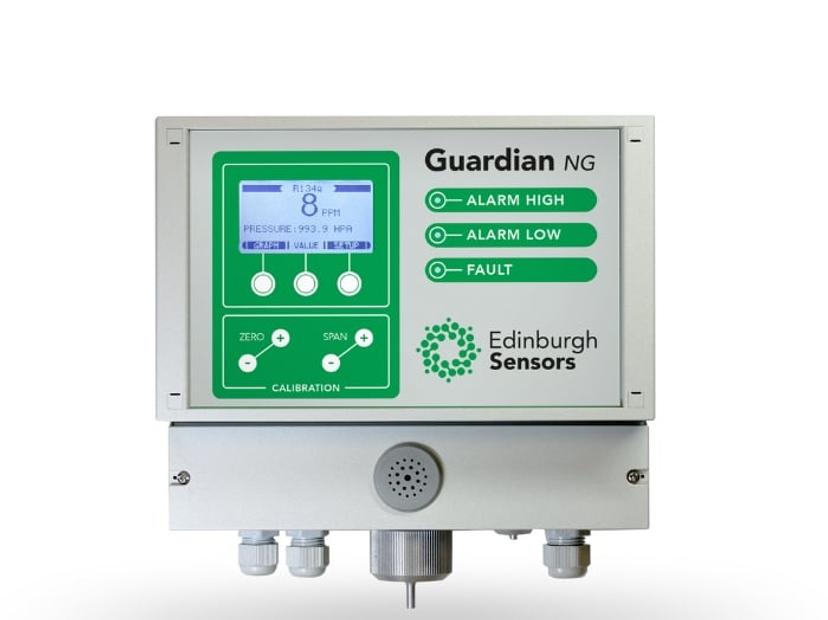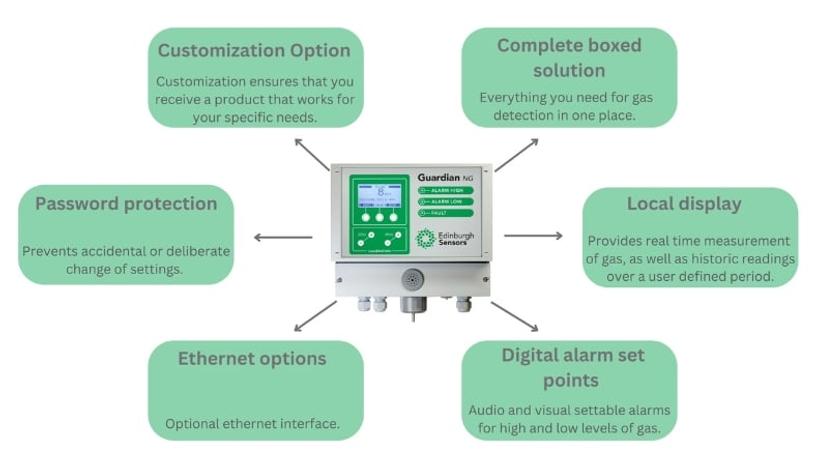The importance of gas detection in agriculture
Gas detection in agriculture is essential for ensuring the safety of workers, livestock, and crops
24 Apr 2024

With over 50 years of knowledge, Techcomp Lab products by Edinburgh Sensors has become one of the world’s leading manufacturers of gas detection instruments with a global reputation for high performance. With a diverse and robust range of gas sensors for fast and reliable gas detection, all manufactured within the United Kingdom.
Key points
- Within the food and drink industry, the Guardian is an ideal solution for gas sensing, the non-dispersive infra-red (NDIR) gas monitor offers the highest accuracy in a fully enclosed system
- The Guardian comes with a customization option, to ensure the product works for specific needs
- The Guardian is the optimal product for your gas sensing requirements, and provides fast, accurate, and reliable gas measurement of both carbon dioxide and methane
- Gas detection of both carbon dioxide and methane is essential to ensure sustainable practices and optimized processes in agriculture
Agriculture and the Guardian
Agriculture encompasses a wide range of activities which includes soil cultivation, producing crops, and raising livestock. Industries within agriculture include crop growing, dairy farming, and horticulture, with all of these relying on gas sensors like the Guardian NG Gas Monitor by Techcomp Lab Products. Gas sensors play a vital role in modern day agriculture, as they ensure that the appropriate atmosphere is obtained for process optimization.
The Guardian NG Gas Monitor is an optimal product for all agricultural gas detection requirements, and provides fast, accurate, and reliable gas measurements. Depending on user requirements, different gas detection systems can be found, for example, in crop growing it is essential to measure carbon dioxide, whereas in dairy farming methane gas production is measured. Monitoring these gases is vital due to sustainability practices and requirements for optimized crop yields for an ever-growing population. Techcomp Lab Products also offers product customization, to facilitate products that are tailored to exact requirements.
The Guardian gas monitor range offers high accuracy, with continuous atmospheric sampling for the detection and measurement of gases. It comes with a fully enclosed gas detector system, and contains a local display and sampling pump. The Guardian is available in two models, Guardian NG Gas Monitor, Guardian NG DC Gas Monitor:
- Guardian NG Gas Monitor – uses a normal AC power supply
- Guardian NG DC Gas Monitor – used when a normal AC power supply is unavailable
Both models provide high accuracy detection and measurement of either CO2 or CH4 gases, with a detection level range between 0–3000 ppm.
Vital for crop growing
The Guardian plays an essential role in optimizing crop growth within the agriculture industry to help ensure healthy yields. For example, greenhouses must measure and control temperature and carbon dioxide levels for optimal crop production. The Guardian provides long-term continuous measurement of carbon dioxide. Monitoring levels of carbon dioxide allows farmers to optimize plant photosynthesis and overall plant health.
A specific subset of crop growing is horticulture, which plays a vital role in food production, and bridges the gap between gardens and larger agricultural systems. Controlled environment horticulture is designed to further optimize the growing conditions of plants, with sophisticated computer controlled sensors to monitor all aspects of plant health, which includes the level of nutrients, humidity, pH, and carbon dioxide.
The Guardian has a crucial function in controlled environment horticulture through various aspects:
- Carbon dioxide control – Monitoring carbon dioxide levels is essential, as the level of CO2 affects the rate of plant photosynthesis. The Guardian ensures reliable and accurate CO2 measurement, and therefore optimizes plant growth and health.
- Climate change scenarios – Climate change has a significant impact on horticulture, as it can alter growing conditions for plants, and therefore climate change scenarios need to be researched so that horticulture practices can be adapted to ensure successful crop growth in all conditions. The Guardian allows for simulation of agriculture climate change scenarios, and aids in mitigation strategies.
- Dual wavelength non-dispersive infrared sensor – The sensor allows for precise CO2 measurement, which is essential in horticulture practices. The Guardian employs this advanced sensor technology with built-in temperature correction for optimal crop growth.
Overall, the Guardian is an optimal solution for crop growing needs, and allows for the creation of crop growth conditions to enhance productivity, as well as adapt to an everchanging environment.
Dairy farming
Dairy farming is a type of agriculture which is focused on producing milk as well as other dairy based products such as cheese and butter.
The Guardian is able to monitor either CO2 levels or methane (CH4) depending on user requirement, and monitoring CH4 emissions is crucial in dairy farming. Methane is a colourless and odourless greenhouse gas which is extremely volatile, therefore methane monitoring is essential for health and safety, particularly for industries where methane is a byproduct. Whilst methane has a shorter atmospheric lifetime than CO2, its greenhouse effect is much greater, therefore monitoring of this gas is crucial. Methane is a byproduct in the dairy farming industry, as cattle produce methane as part of their normal digestive process.
The Guardian plays a crucial role in monitoring methane levels in dairy farming through various aspects:
- Greenhouse gas emissions – CH4 is one of the most prevalent greenhouse gases emited due to human activities. Cows produce methane when they defecate or burp, and this methane is released into the atmosphere. Agriculture is the primary global source of CH4, and therefore it is essential to both monitor and reduce these emissions. The Guardian is an ideal solution for these requirements. The rapid response time is beneficial, as it allows for samples from multiple cattle to be analysed and processed quickly. This cost-effective product is also a completely non-invasive solution for methane monitoring of cattle.
- Sustainability practices – By monitoring methane levels, we are able to identify any variations in emission, as well as study individual cow emission, and test mitigation strategies. Finding ways to reduce methane production from cows is a highly active area of research. A significant portion of this research being dedicated to altering the digestive pathway of cows to reduce methane gas emission. Some success has been found by changing the cows diets, which can in turn alter the microbes found in their stomach. All of this vital research relies on being able to monitor methane gas production from cows accurately. The change in methane emission could be small, and therefore sensing technologies which are sensitive as well as accurate are required. An effective solution for this is non-dispersive infra-red (NDIR) sensing technology, as methane highly absorbs infra-red light. The Guardian is a type of NDIR device, and is therefore an ideal solution for methane monitoring, and will provide accurate methane gas readings even for small changes in the environment.
Key features of the Guardian
The guardian is the ideal products for all your gas sensing needs, and with the customization option, you can tailor it to your specific requirements, to ensure a product that is right for you.

This article was written by Lauren Dalziel, Application Scientist at Techcomp.
*Product images may vary.

